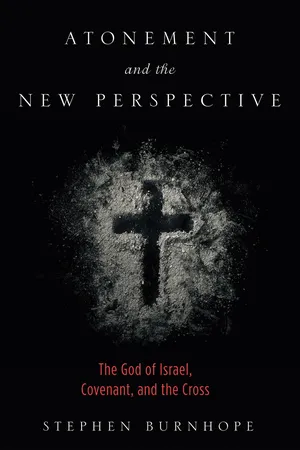![]()
chapter one
The Doctrine of Atonement
How can a judicial murder be represented as a salvific event? This is the kind of question that has driven the church to seek a theology of atonement. Many such theories have been produced and there is no single one that is universally accepted. At the best, we can only hope to have a number of analogies and metaphors, correcting and supplementing each other but together conveying something of the mystery of the cross as it has been experienced in Christian faith.
1.1 Introduction
The Christian doctrine of atonement is attempting to answer the question of how, exactly, humanity is made “at one” with God through the person and work of Christ—or, in the language of Middle English, restored to a state of “at-one-ment.” Given its critical importance, it is unsurprising that Leon Morris should describe the atonement as “the central doctrine of Christianity.” One might therefore be forgiven for finding it curious that no particular or exclusive understanding of atonement has ever been insisted upon by the church as determining Christian orthodoxy. As J. N. D. Kelly sums it up, “While the conviction of redemption through Christ has always been the motive force of Christian faith, no final and universally accepted definition of the manner of its achievement has been formulated to this day.” Accordingly, one can inhabit the land of Christian orthodoxy, classically defined, without embracing one particular theory of the atonement. Through the centuries, atonement has been explained by reference to sundry analogies and metaphors deriving from biblical imagery, mediated through contemporary thought, each “conveying something”—in John Macquarrie’s phrase, quoted above—of how the cross of Christ is salvific.
Theological consideration of atonement has tended to focus either on arguing for a preferred theory or, alternatively, on how the various theories ought to be understood to fit together. A recent example of this is the debate within Evangelicalism concerning the claimed hegemony of the penal substitutionary doctrine (on which, more anon). However, the burden of this particular work lies elsewhere. Perhaps the most curious thing about all of the traditional Christian accounts of atonement is the virtual absence of any meaningful reference to the historic relationship between Israel and its God within which the atoning work of Christ took place. To all intents and purposes, atonement has been abstracted from the religious context in which it was achieved—it has come adrift from its Jewish moorings. It is as if the entire narrative of Israel and its God up until that point has no material bearing on the Christian doctrinal perspective, notwithstanding that Jesus was speaking to Jews from within Judaism and that his immediate followers were all Jews. It seems that a conflation has occurred, in which the fact that Christ’s work has universal and timeless significance has been confused with the idea that atonement is to be explained in universalized and dehistoricized terms. The doctrine of atonement exemplifies what Soulen calls an “Israel-forgetfulness”; namely, that
Soulen’s insight offers the intriguing idea of looking at the subject of atonement through the opposite end of the telescope—that is to say, with a presumption that God’s identity as the God of Israel and the center of the Hebrew Scriptures is actually decisive for grasping his antecedent purpose and that accounting for the gospel’s truth might somehow depend on such a construal. This would be a radical change of direction from the assumption that an old and inferior religion called Judaism is the province of the Old Testament, while a new and better religion called Christianity is the province of the New. It would render null and void any on-going construal of Christian faith that sought to define its own qualities over against Judaism’s corresponding failings. It would necessitate reversing the tendencies in Christian history to separate Jesus from his Judaism and to espouse an essentially ahistorical gospel beginning with a decontextualized and universalized Savior.
However, the development of such an account must await chapter three. The purpose of this present chapter is a discussion of the current state-of-play concerning how atonement is and has historically been understood and an analysis of its key themes. We will reflect on the manner in which its theories, models, and metaphors construe the interaction of the “problem” with its corresponding “solution” and the role that is played in that construal by culture and worldview. Given our chosen scholarly context, we will be mostly concerned to consider Evangelicalism’s perspective. This will necessitate addressing, in particular, the claims to hegemony of the penal substitutionary doctrine, since Evangelicalism widely perceives this to be “obviously” the principal and necessary biblical understanding. Self-evidently, were this to be the case, there would be no “gap” to fill, whether with reference to the story of Israel or anything else.
The chapter will therefore develop as follows. To begin, we will look at atonement in history. Here, we will firstly note the absence of creedal confessional affirmations concerning the atonement. Secondly, we will briefly review how atonement has been conceived historically, through various “objective” or “subjective” models, metaphors, or theories. Thirdly, we will consider in depth the principal Evangelical idea of the atonement—penal substitution. Finally, we will contrast that approach with the alternative multi-faceted or “kaleidoscopic” understanding that many prefer.
In the second part of the chapter we shall briefly review the work of a few scholars who may be perceived already to have taken some steps along the same path, in offering a contribution to atonement theory drawn from aspects of the biblical story of Israel.
As the chapter develops, we shall see time and again that—whether we are talking about the traditional models or recent thinking—“Israel-forgetfulness” is to the fore. We find this to be so in both parts of the chapter. Even where atonement accounts touch upon Old Testament “themes” it will be evident that they draw no necessary or substantive ...
